
A | B | C | D | E | F | G | H | CH | I | J | K | L | M | N | O | P | Q | R | S | T | U | V | W | X | Y | Z | 0 | 1 | 2 | 3 | 4 | 5 | 6 | 7 | 8 | 9

National Historic Site (NHS) and National Historical Park (NHP) are designations for officially recognized areas of national historic significance in the United States. They are usually owned and managed by the federal government. An NHS usually contains a single historical feature directly associated with its subject, while an NHP is an area that generally extends beyond single properties or buildings to include a mix of historic and later structures and sometimes significant natural features.[1]
As of 2024, there are 63 NHPs and 85 NHSs. Most NHPs and NHSs are managed by the National Park Service (NPS). Some federally designated sites are owned by local authorities or privately owned, but are authorized to request assistance from the NPS as affiliated areas.[2] One property is managed by the U.S. Forest Service, Grey Towers National Historic Site.[3]
As of October 15, 1966, all historic areas, including NHPs and NHSs, in the NPS are automatically listed on the National Register of Historic Places (NRHP). There are also about 90,000 NRHP sites, the large majority of which are neither owned nor managed by the NPS. Of these, about 2,500[4] have been designated at the highest status as National Historic Landmark (NHL) sites.
History
After its founding in 1916, the National Park Service initially oversaw sites of primarily scenic and natural significance, including national parks and national monuments. Historians soon began recommending preservation of sites relating to human history.[5] Congress created Colonial National Monument in 1930 to protect the Jamestown Settlement and Yorktown battlefield in Virginia as one of the first new historical areas, and it was renamed a national historical park in 1936.[5] Morristown National Historical Park, the 1779–1780 winter encampment of the Continental Army in New Jersey, was established on March 2, 1933, as its largest historical area. The U.S. House committee noted that the new designation was logical for the area and set a new precedent, with comparison to the national military parks, which were then in the War Department. The park's establishment allowed the NPS to have an administrative historical program with professional historians.[6] President Franklin D. Roosevelt reorganized the agency to also oversee memorials and military parks with historic significance later in 1933, substantially broadening the NPS's mandate.[7]
In 1935, Congress passed the Historic Sites Act (Pub. L. 49–666), which established that "it is a national policy to preserve for public use historic sites, buildings and objects of national significance for the inspiration and benefit of the people of the United States."[8] This expanded upon the Antiquities Act of 1906, which gave the President the ability to order "the protection of objects of historic and scientific interest." The Historic Sites Act directed the National Park Service to survey historic sites which may be of national significance, as well as restore and acquire properties. The Historic American Buildings Survey began to document the country's architectural heritage and identify buildings for potential protection. Initially the Secretary of the Interior could designate national historic sites, though this did not include funding for acquition or administration without congressional action.[7] Salem Maritime National Historic Site was the first place to be preserved as a national historic site, created by secretarial order on March 17, 1938.[9] It had followed Secretary Harold L. Ickes's designation of the Jefferson National Expansion Memorial in 1935; many historic sites in the National Park System continue to be protected under different designation types.[7] Hopewell Furnace National Historic Site was designated later that year, another example of industrial heritage.
As the NPS developed criteria for nationally significant historic sites in the late 1930s, it aimed to identify unique sites that could each tell a broad story and would fit together to cover all aspects of American history. Surveys of sites were guided by themes and chronologies to ensure a diverse and comprehensive selection of those most representative of different eras and geographies, with less political influence over site selection.[10] In the 1950s, the Mission 66 program revived historic studies that had lagged during World War II and saw the creation of the National Historic Landmarks program as a method to recognize important sites. From the 1960s to 1990s, the NPS evolved from a thematic framework, in which numerous specific themes and subthemes of American history were expected to each be included in some way in the system,[11] to a conceptual framework, whereby both new and existing park units would be examined more holistically for ways to study history such as "creating social movements and institutions," "developing the American economy," and "peopling places." In the 20th century, potential new park units have been recommended not so much on "an orderly, balanced, and comprehensive" preservation of "outstanding examples", as Chief Historian Ronald Lee put it, but on those mandated to be studied by Congress, most of whose requests are recommended against by the NPS.[10]
A 1973 NPS publication outlined policies for administration of historical areas, which were distinct from its natural and recreational areas. This included not only NHSes and NHPs but also national military parks, national battlefields, national battlefield parks, national battlefield sites, national memorial, and some national monuments; at that time there were 178 such areas, and management focused on "maintaining and where necessary restoring the historical integrity of structures, sites and objects significant to the commemoration or illustration of the historical story".[12] But because most units contained a combination of natural, historic, and recreational lands, the General Authorities Act of 1970 made all areas equal within the National Park System;[13] separate policy manuals for each were replaced in 1975 with one that would tailor policies in each park respective to the purpose of zones within.[7]
National Historic Sites
National Historic Sites are generally federally owned and administered properties, though some remain under private or local government ownership. There are currently 85 NHSs, of which 75 are official NPS units, 9 are NPS affiliated areas, and one is managed by the United States Forest Service.
Derived from the Historic Sites Act of 1935, a number of NHSs were established by United States Secretaries of the Interior, but most have been authorized by acts of Congress. In 1937, the first NHS was created in Salem, Massachusetts, in order to preserve and interpret the maritime history of New England and the United States.
| Name | Image | Location | Area[14] | Description |
|---|---|---|---|---|
| Allegheny Portage Railroad | 
|
Pennsylvania | 1,284.27 acres (5.1973 km2) | The Allegheny Portage Railroad was the first railroad through the Allegheny Mountains in central Pennsylvania that connected the Midwestern United States to the Eastern seaboard, used as a portage railway to haul river boats and barges over the divide between the Ohio and the Susquehanna Rivers.[15] |
| Amache | 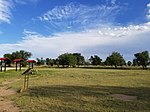
|
Colorado | Granada War Relocation Center, or Camp Amache, was a concentration camp where more than 10,000 Japanese Americans were interned during World War II.[16] | |
| Andersonville | 
|
Georgia | 515.61 acres (2.0866 km2) | The Andersonville National Historic Site, a former Confederate prisoner-of-war camp, is located near Andersonville, Georgia. The prison operated during the final fourteen months of the American Civil War, February 1864 - April 1865. It was overcrowded, with an inadequate water supply, inadequate food, and unsanitary conditions. Of the roughly 45,000 Union prisoners held there during the war, nearly 13,000 died.[17] |
| Andrew Johnson | 
|
Tennessee | 16.68 acres (0.0675 km2) | Andrew Johnson was elected vice president in 1864 and was sworn in as 17th President of the United States after the assassination of President Lincoln on April 15, 1865. The historic site encompasses the homestead in Greeneville, Tennessee, that he and his family lived in.[18] |
| Bent's Old Fort | 
|
Colorado | 798.54 acres (3.2316 km2) | Bent's Old Fort was built in 1833 in southeastern Colorado. Before it was destroyed in 1849, the fort was the only major white American permanent settlement on the Santa Fe Trail between Missouri and the Mexican settlements to support trade with trappers and Southern Cheyenne and Arapaho Plains Indians.[19] |
| Boston African American | 
|
Massachusetts | 0.59 acres (0.0024 km2) | The Beacon Hill neighborhood was home to most of Boston's Black population before the Civil War, much of whom were slaves who escaped via the Underground Railroad. Sites on the Black Heritage Trail include the 1806 African Meeting House, the oldest standing black church in the United States; the Robert Gould Shaw Memorial; schools; and homes of several abolitionists.[20] |
| Carl Sandburg Home | 
|
North Carolina | 268.49 acres (1.0865 km2) | Carl Sandburg Home National Historic Site is located in the village of Flat Rock, North Carolina, and preserves Connemara, the home of Pulitzer Prize-winning poet and writer Carl Sandburg. Sandburg and his family moved here in 1945 for the peace and solitude needed for his writing and for the roughly 30 acres of pastureland for his wife, Lilian, to raise her champion dairy goats.[21] |
| Carter G. Woodson Home | 
|
Washington, D.C. | 0.15 acres (0.00061 km2) | Carter G. Woodson, the pioneering historian, author, and journalist who founded Black History Month, lived in this three-story rowhouse from 1922 until his death in 1950. There he operated the Association for the Study of Negro Life and History and published the Negro History Bulletin and the Journal of Negro History.[22] |
| Charles Pinckney | 
|
South Carolina | 28.45 acres (0.1151 km2) | Charles Pinckney was a South Carolinian governor, Founding Father, and signer of the United States Constitution. He served as South Carolina's governor for four terms; his first two terms ran consecutively from 1789 to 1792, his third from 1796 to 1798, and his fourth from 1806 to 1808.[23] Pinckney used the site, which was then known as Snee Farm, as a plantation and country retreat.[24] |
| Chicago Portage (affiliated area) |

|
Illinois | 91.2 acres (0.369 km2) | The Chicago Portage served as one of the "most important travel routes of the mid-continent."[25] In 1673, explorers Jacques Marquette and Louis Jolliet first crossed the Chicago Portage. The site marks the western end of the historic portage linking the Great Lakes to the Mississippi River[26] with a statue of Marquette, Jolliet, and a Native American with a canoe. The statue was created by artist Ferdinand Rebechini.[27] |
| Chimney Rock (affiliated area) |

|
Nebraska | 83 acres (0.34 km2) | Chimney Rock is a prominent geological rock formation in western Nebraska that served as a landmark along the Oregon Trail, the California Trail, and the Mormon Trail during the mid-19th century.[28] |
| Christiansted | 
|
U.S. Virgin Islands | 27.15 acres (0.1099 km2) | Christiansted, the capital of the former Danish West Indies on St. Croix Island, was an important part of the urban development of the Virgin Islands and the influence of the Dutch on the area.[29] The site consists of six historical sites, including Fort Christianvaern, a Dutch fort that now serves as one of the best-preserved examples of Caribbean colonial fortification.[30] |
| Clara Barton | 
|
Maryland | 8.59 acres (0.0348 km2) | Clara Barton, humanitarian and founder of the American Red Cross, lived in this house from 1897 until her death in 1912. The house served as headquarters and a warehouse for the Red Cross. When it was established in 1974, the Clara Barton National Historic Site was the first national historic site dedicated to the accomplishments of a woman.[31] |
| Edgar Allan Poe | 
|
Pennsylvania | 0.52 acres (0.0021 km2) | Edgar Allan Poe, regarded as a major figure in the American Romanticism movement, lived in this house. He likely rented it for a year or less in 1843, but it remains Poe's only residence still standing in Philadelphia. The site details Poe's time in Philadelphia, where he wrote some of his most famous works including "The Tell-Tale Heart" and "The Raven".[32] |
| Eisenhower | 
|
Pennsylvania | 690.46 acres (2.7942 km2) | Dwight D. Eisenhower, the 34th President of the United States and Five-Star General, lived in this home from 1950 until two years before his death in 1969. While president and afterwards, Eisenhower hosted many important dignitaries, politicians, and foreign leaders at the house.[33] |
| Eleanor Roosevelt | 
|
New York | 180.50 acres (0.7305 km2) | Eleanor Roosevelt, the First Lady from 1933 to 1945 and Ambassador to the United Nations, used this property, named Val-Kill, for both personal entertainment, hosting, and helping employ local farming families in handcraft traditions. The site now commemorates Roosevelt's life and accomplishments.[34] |
| Eugene O'Neill | 
|
California | 13.19 acres (0.0534 km2) | The only American playwright to win a Nobel Prize in Literature, Eugene O'Neill bought this site, which he called Tao House, with the money awarded to him for the aforementioned prize. He lived in the house from 1937 to 1944, writing plays such as The Iceman Cometh and A Moon for the Misbegotten.[35] |
| Fallen Timbers Battlefield and Fort Miamis (affiliated area) |

|
Ohio | 9 acres (0.036 km2) | The Battle of Fallen Timbers, a decisive American victory over Native American and British opponents which effectively ended the Northwest Indian War, was fought on this site on August 20, 1794. Originally, a site in nearby Maumee was incorrectly identified as the battle site, but this area has since been renamed the Fallen Timbers State Memorial and is now preserved as a part of this park.[36] |
| First Ladies | 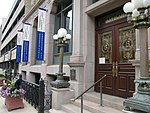
|
Ohio | 0.46 acres (0.0019 km2) | Commemorating the accomplishment of First Ladies of the United States, this site holds exhibits on the evolving roles of first ladies in the American presidency and American society. The site also preserves the home of First Lady Ida McKinley.[37] |
| Ford's Theatre | 
|
Washington, D.C. | 0.30 acres (0.0012 km2) | President Abraham Lincoln was assassinated on April 14, 1865 while watching a performance of Our American Cousin at Ford's Theatre. He was brought across the street to the Petersen House where he died the next morning. The theatre continues to produce live plays and has a museum of artifacts related to Lincoln, and the Petersen House, the first historic home purchased by the U.S. government, is furnished as it was the night Lincoln died.[38] |
| Fort Bowie | 
|
Arizona | 999.45 acres (4.0446 km2) | A United States Army outpost established in 1862 by the California Volunteers. The base was the focal point of military operations in the Apache Wars, including the surrender of Geronimo in 1886 and the banishment of the Chiricahuas to Florida and Alabama thereafter.[39] |
| Fort Davis | 
|
Texas | 523.00 acres (2.1165 km2) | Originally established in 1854 to protect emigrants, mail coaches, and freight wagons on the trans-Pecos portion of the San Antonio-El Paso Road and the Chihuahua Trail, the fort saw very sparse use. Thus, it remains one of the best examples of a United States Army fort in the southwestern United States. The fort also holds particular importance in regards to African-Americans in the army, as the 9th and 10th Cavalry regiments (all-black regiments also known as "The Buffalo Soldiers") were stationed at Fort Davis after the Civil War, helping rebuild the site.[40] |
| Fort Laramie | 
|
Wyoming | 873.11 acres (3.5334 km2) | Founded as a private trading-post in the 1830s to service the overland fur trade, the site became an important trading post due to its location near the South Pass of the Rocky Mountains. The fort was purchased by the United States Army in 1849 to protect the many wagon trains of migrant travelers on the Oregon Trail. Fort Laramie was also a notable stop on the Mormon Trail.[41] |
| Fort Larned | 
|
Kansas | 718.39 acres (2.9072 km2) | Established in 1859 as the Camp on Pawnee Fork, the site protected travelers on the Santa Fe Trail from hostile Native Americans. The fort saw occasional use during various Native American conflicts throughout the 1800s and was raided by Kiowa Indians in 1864. In 1867, the fort served as a meeting place for General Winfield Scott Hancock and chiefs from the Cheyenne tribe, indirectly beginning Hancock's War.[42] |
| Fort Point | 
|
California | 29.00 acres (0.1174 km2) | Originally established in 1794 by Spain, the fort was captured by the United States in the Mexican-American War and refortified in the 1840s during the gold rush. The modern Fort Point was completed in the 1850s, but saw little use. In 1937, the Golden Gate Bridge was built directly above the fort, though it is a part of the Golden Gate National Recreation Area and not the site itself.[43] |
| Fort Raleigh | 
|
North Carolina | 515.73 acres (2.0871 km2) | This site preserves Roanoke Colony, the first English settlement in the present-day United States. Founded in 1587 by Sir Walter Raleigh, the colony was abandoned sometime between 1587 and 1590 and no survivors were discovered; many have dubbed it the "Lost Colony". During the American Civil War, the site became the Roanoke Island Freedmen's Colony, a contraband camp for slave refugees overseen by the Union Army.[44] |
| Fort Scott | 
|
Kansas | 20.11 acres (0.0814 km2) | Established in 1842 as a midway point between Fort Leavenworth and Fort Gibson, Fort Scott provided protection to settlers migrating west from Native Americans in the Great Plains. The site saw little attention until the passage of the Kansas-Nebraska Act in 1854. Free-soilers and pro-slavery advocates occupied separate parts of the fort, leading to continued conflict. The Union Army took the fort during the American Civil War, holding it throughout the war.[45] |
| Fort Smith | 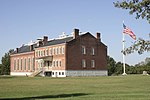
|
Arkansas, Oklahoma | 75.00 acres (0.3035 km2) | Established in 1871, Fort Smith contains the building which once housed the United States District Court for the Western District of Arkansas, which had jurisdiction over federal cases in Indian Territory. The fort was also a stop on the Trail of Tears for the Choctaw and Cherokee people. The site contains a walking tour detailing the forced relocation.[46] |
| Fort Union Trading Post | 
|
Montana, North Dakota | 440.14 acres (1.7812 km2) | Fort Union was regarded as the most important fur trading post on the upper Missouri River, as it is situated at the confluence of the Missouri and its tributary, the Yellowstone River. Much of the site is a modern reconstruction based on archaeological excavations and contemporary drawings.[47] |
| Fort Vancouver | 
|
Washington, Oregon | 206.72 acres (0.8366 km2) | The Hudson's Bay Company had their northwest headquarters at Fort Vancouver, where they operated the fur trade and oversaw vast territory in the 1820s to 1840s. A reconstructed fort shows life in the Columbia District. It is adjacent to the Pearson Air Museum and the U.S. Army's former Vancouver Barracks, and the home of HBC superintendent John McLoughlin is in Oregon City.[48] |
| Frederick Douglass | 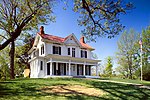
|
Washington, D.C. | 8.57 acres (0.0347 km2) | Frederick Douglass was a prominent abolitionist who gave speeches and wrote books about his time enslaved and social reform. He spent the last 17 years of his life at this home, called Cedar Hill, in the Anacostia neighborhood, where he wrote an autobiography and was a member of D.C. society. The house is restored with many of Douglass's original belongings.[49] |
| Frederick Law Olmsted | 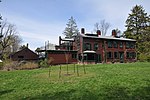
|
Massachusetts | 7.21 acres (0.0292 km2) | Frederick Law Olmsted was an influential landscape architect, responsible for such projects as Central Park in New York City and the Emerald Necklace around Boston. Olmsted moved to this site, called Fairsted, in 1883 and established the world's first full-scale professional office for the practice of landscape design. His sons and successors would continue the practice for the next century.[50] |
| Friendship Hill | 
|
Pennsylvania | 674.56 acres (2.7298 km2) | Albert Gallatin, a notable early American politician and the longest-serving Secretary of the Treasury, lived in this estate from 1788 to 1832. During this time, Gallatin was instrumental in reducing the national debt, purchasing the Louisiana Territory and funding the Lewis and Clark Expedition; an obscure figure in modern times, the Park Service dubs Gallatin the "forgotten founding father".[51] |
| Gloria Dei (Old Swedes') Church (affiliated area) |

|
Pennsylvania | 3.7 acres (0.015 km2) | Swedish immigrants were an important part of early Pennsylvanian history, with New Sweden existing in current-day Philadelphia from 1638 to 1655. This church, known locally as Old Swedes', is the oldest church in Pennsylvania and the second-oldest Swedish church in the United States. The site highlights the influence of Swedish culture and people on early America.[52] |
| Grant–Kohrs Ranch | 
|
Montana | 1,618.43 acres (6.5496 km2) | Originally established for fur trading in 1862, this ranch would eventually grow to cover over ten million acres of Powell County, Montana under the ownership of cattle baron Conrad Kohrs. Though the current-day park is only 1,618 acres, it illustrates the role of cattlemen in American history.[53] |
| Grey Towers | 
|
Pennsylvania | 102 acres (0.41 km2) | Also known as the Gifford Pinchot House or the Pinchot Institute, this house was the home of Gifford Pinchot, the first head of the United States Forest Service. The house was commissioned in 1884 by Pinchot's father, James Pinchot, and remained in the Pinchot family until 1960, when the property was donated to the Forest Service. It became a National Historic Landmark shortly thereafter, one of the first places in the country to be designated as such.[54] |
| Hampton | 
|
Maryland | 62.04 acres (0.2511 km2) | The 1790 Georgian style Hampton Mansion was once the largest residence in America and has several rooms with original furnishings and artworks; it is the only NPS site preserved for its architectural merit. Long owned by the aristocratic Ridgely family, the plantation estate had more than 300 enslaved people farming and maintaining the grounds, which include terraced gardens, a farm house, and original slave quarters.[55] |
| Harry S. Truman | 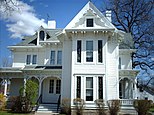
|
Missouri | 12.59 acres (0.0509 km2) | Harry Truman served as the 33rd President of the United States, overseeing the end of World War II. Though born in nearby Lamar, Missouri, Truman lived in this house after marrying his wife Bess Truman in 1919 until his death in 1972. The house itself was built by Bess Truman's maternal grandfather and stands across the street from her birthplace. Though Truman's legal name was Harry S. Truman, the site's name is officially styled without a period following S, his middle name.[56] |
| Herbert Hoover | 
|
Iowa | 186.80 acres (0.7560 km2) | 31st President of the United States Herbert Hoover lived in West Branch, Iowa for the first eleven years of his life, with the cottage he lived in from 1879 to 1884 serving as the Hoover's only remaining residence at the site. The site also includes several associated buildings related to the Hoover's life in West Branch, including a recreation of Hoover's father's blacksmith shop and the home of Hoover's uncle Laban Miles, an Indian Agent for Rutherford B. Hayes. Hoover and his wife, Lou, are both buried within the site's grounds.[57] |
| Home of Franklin D. Roosevelt | 
|
New York | 838.43 acres (3.3930 km2) | Franklin D. Roosevelt, the 32nd and longest-serving President of the United States, was born and raised at Springwood, his family's estate on the banks of the Hudson River. Roosevelt essentially lived at Springwood his entire life, and frequently visited even during his presidency. It also served as one of Roosevelt's Summer White Houses, where he hosted foreign dignitaries such as King George VI and William Lyon Mackenzie King. Roosevelt, his wife, Eleanor, and their dog Fala are buried together at the site.[58] |
| Honouliuli | 
|
Hawaii | 154.46 acres (0.6251 km2) | The Honouliuli Internment Camp, Hawaiʻi's largest and longest-operating internment camp, opened in 1943 and closed in 1946. The camp imprisoned prisoners of war during World War II, at its height imprisoning nearly 4,000 and making it the largest prisoner of war camp in Hawaiʻi. Japanese-Americans were also interned at the site following Executive Order 9066.[59] |
| Hopewell Furnace | 
|
Pennsylvania | 848.06 acres (3.4320 km2) | The Hopewell Furnace was an iron plantation from 1771 to 1883, producing pig iron and cast iron products as a self-sufficient community. The blast furnace was fed by huge quantities charcoal made from the surrounding forests, though anthracite coal was briefly used for smelting instead. A restored water wheel continues to pump air for the furnace. Community buildings include the Ironmaster's Mansion, office, barn, church, and workers' quarters.[60] |
| Hubbell Trading Post | 
|
Arizona | 160.09 acres (0.6479 km2) | Following the Long Walk of the Navajo, many Navajo returned to the Ganado region of Arizona to restart their lives. Finding their homes and crops devastated, trade became an important means of economic growth for the Navajo. Established in 1878, J. Lorenzo Hubbell's trading post in Ganado, Arizona serves as the oldest operating trading post on the Navajo Nation.[61] |
| James A. Garfield | 
|
Ohio | 7.82 acres (0.0316 km2) | 20th President of the United States James A. Garfield was assassinated less than a year into his term, yet lived an accomplished life as an attorney, member of the Ohio State Senate, and United States Representative. The site preserves Garfield's home from 1876 until his death, as well as his presidential library, as he was the first president to have one.[62] |
| Jamestown (affiliated area) |
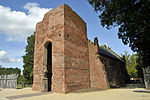
|
Virginia | 20.63 acres (0.0835 km2) | James Fort was established on Jamestown Island in 1607 as the first permanent English settlement in North America. The fort eventually evolved into the town of Jamestown, Virginia (also spelled Jamestowne). The site is owned and operated by the National Park Service and Preservation Virginia, also serving as a unit of Colonial National Historical Park.[63] |
| John Fitzgerald Kennedy | 
|
Massachusetts | 0.09 acres (0.00036 km2) | John F. Kennedy was a part of the Kennedy political family and served as the 35th President of the United States. Purchased in 1914, John and his sisters Rosemary and Kathleen were the only Kennedys born in the house, as the Kennedy family moved in 1920. Rose Kennedy purchased the property again in 1966 to restore it to its 1914 appearance, donating it to the National Park Service the following year.[64] |
| John Muir | 
|
California | 344.14 acres (1.3927 km2) | John Muir, an early advocate for the preservation of wilderness in the United States and the "Father of the National Parks", lived in this house from 1897 until his death in 1914. While here, Muir co-founded the Sierra Club and served as its first president. He also wrote hundreds of magazine and newspaper articles, essays, and books advocating for the preservation of American wilderness, such as preventing Yosemite National Park's Hetch Hetchy Valley from being dammed. Though he died before its founding, Muir is often credited as a major figure in the development of the National Park Service.[65] |
| Kate Mullany (affiliated area) |

|
New York | Kate Mullany, leader of the Collar Laundry Union in Troy, New York, lived and worked in this house as she organized local women's labor movements. Mullany's union was one of the first women's unions that lasted longer than the resolution of a specific issue.[66] | |
| Knife River Indian Villages | 
|
North Dakota | 1,751.00 acres (7.0860 km2) | Preserves the historic and archaeological remnants of bands of Hidatsa, Northern Plains Indians, in Stanton, North Dakota. Knife River was a major trading and agricultural area and the area was home to the villages of Awatixa Xi'e, Awatixa, and Big Hidatsa Village.[67] |
| Lincoln Home | 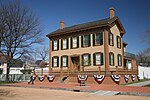
|
Illinois | 12.24 acres (0.0495 km2) | Abraham Lincoln, 16th President of the United States, lived in this house from 1844 to 1861 while practicing law and serving in the United States House of Representatives. Lincoln also lived in this house when he was elected president in 1860. In addition to Lincoln's house, several other structures within the four-block area are also preserved and have been restored to their appearance during the time Lincoln lived in the neighborhood.[68] |
| Little Rock Central High School | 
|
Arkansas | 28.22 acres (0.1142 km2) | When opened in 1927, Little Rock Central was the nation's largest and most expensive high school facility. In 1957, the school gained international attention during the Little Rock Integration Crisis, when nine African-American students were denied entry to the school by students, protestors, and the state's governor. As this was in defiance to the recent ruling of Brown v. Board of Education, President Dwight D. Eisenhower deployed the 101st Airborne Division and the Arkansas National Guard to escort the students to school and deter protestors. The school itself is not open to the public as part of the site, but nearby visitor centers tell the school's history and provides streetscape walking tours with park rangers.[69][70] |
| Longfellow House–Washington's Headquarters | 
|
Massachusetts | 1.98 acres (0.0080 km2) | During the Siege of Boston, General (and later President of the United States) George Washington used this house as his headquarters and base of operations. Washington was based in the house for less than a year between 1775 and 1776; the house was later owned by popular fireside poet Henry Wadsworth Longfellow. The Longfellow family owned the house 1843 to 1972.[71] |
| Lower East Side Tenement (affiliated area) |

|
New York | Built in 1863, the site is estimated to have housed 15,000 people from over 20 nations between 1863 and 2011. New York City was an epicenter for European immigration in the 19th and 20th centuries, with many immigrants arriving via Ellis Island to live in tenement houses similar to this one. The site promotes tolerance and historical perspective on the immigrant experience.[72] | |
| Maggie L. Walker | 
|
Virginia | 1.29 acres (0.0052 km2) | Maggie L. Walker was an African-American businesswoman who chartered the St. Luke Penny Savings Bank in Richmond, Virginia, making her both the first African-American woman to charter a bank and the first African-American woman to serve as a bank president. Later in life, Walker was bound to a wheelchair as a result of paralysis, also serving as an icon for people with disabilities. Walker lived in this house from 1904 until her death in 1934. The house also contains a preserved elevator, rare for private residences at the time, which Walker used to access the second floor after her paralysis.[73] |
| Manzanar | 
|
California | 813.81 acres (3.2934 km2) | Manzanar was one of ten concentration camps used to imprison Japanese-Americans during World War II following Executive Order 9066. Though one of the smaller camps, more than 120,000 Japanese Americans were incarcerated at the site, with over 10,000 inmates at its peak. The site preserves and interprets the legacy of Japanese-American incarceration in the United States, as it was identified by the National Park Service as the best-preserved of the ten former camp sites.[74] |
| Martin Van Buren | 
|
New York | 284.93 acres (1.1531 km2) | Martin Van Buren, the 8th President of the United States, purchased this house during his presidency in 1839 and lived here until his death in 1862. The property, called Lindenwald, served as the headquarters for Van Buren's unsuccessful 1844 and 1848 campaigns for a second-term as president. Located only a mile away from Van Buren's birthplace in Kinderhook, New York, the house was also owned by local author Washington Irving, who Van Buren later befriended.[75] |
| Mary McLeod Bethune Council House | 
|
Washington, D.C. | 0.07 acres (0.00028 km2) | Mary McLeod Bethune was an important civil rights activist who Franklin D. Roosevelt appointed to his executive council to help create the Black Cabinet. The National Council of Negro Women, founded by Bethune, also occupied the house from its founding in 1935 until 1981. The house highlights the accomplishments of the organization and Bethune's lifelong work to advance the lives of African-Americans.[76] |
| Minidoka | 
|
Idaho | 396.30 acres (1.6038 km2) | The Minidoka War Relocation Center was the first of ten camps where Japanese Americans were imprisoned during World War II. More than 13,000 incarcerees stayed here at hastily built barracks in the high desert, working on camp construction, at its farm, or on the Anderson Ranch Dam. The Bainbridge Island Japanese American Exclusion Memorial, commemorating where 276 residents were removed from their homes, is a unit of Minidoka NHS.[77] |
| Minuteman Missile | 
|
South Dakota | 43.80 acres (0.1773 km2) | During the Cold War, the United States established several missile-building sites in remote parts of the country, including this site near Wall, South Dakota which the 66th Strategic Missile Squadron of the 44th Strategic Missile Wing operated. The facilities represent the only remaining intact components of a nuclear missile field that once consisted of 150 Minuteman II missiles and 15 launch-control centers which covered over 13,500 square miles of southwestern South Dakota.[78] |
| New Philadelphia | 
|
Illinois | 124.33 acres (0.5031 km2) | Founded in 1836, New Philadelphia was the first town in the United States platted and registered by an African-American before the American Civil War. The founder, Free Frank McWorter, was a former slave who was able to save money from work and his own business to purchase the freedom of his wife, then himself, and over time, 13 members of his family from Kentucky. The town no longer exists, having been abandoned between the 1880s and 1920s.[79][80] |
| Nicodemus | 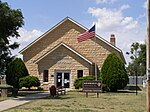
|
Kansas | 4.39 acres (0.0178 km2) | The town of Nicodemus, Kansas was founded in 1877, and serves as the only remaining western town established by African-Americans during the Reconstruction Period following the American Civil War. The site contains several preserved buildings from the town's early history and illustrates westward expansion by African-Americans in post-war America.[81] |
| Ninety Six | 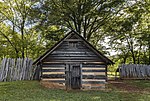
|
South Carolina | 1,021.94 acres (4.1356 km2) | Old Ninety Six and Star Fort, so named for being 96 miles from the Cherokee town of Keowee (though it is actually 78 miles away), as well as the town of Ninety Six, South Carolina were strategic forts for both the Cherokee people and soldiers during the American Revolutionary War. The town of Ninety Six was a Loyalist stronghold during the Revolutionary War, and from May 22 to June 18, 1781, newly appointed Southern Department commander of the Continental Army, Major General Nathanael Greene led 1,000 troops in an unsuccessful siege against the 550 Loyalists defending the fort in the village.[82] |
| Pennsylvania Avenue | 
|
Washington, D.C. | 17.61 acres (0.0713 km2) | The neighborhood around Pennsylvania Avenue between the White House and the United States Capitol has many historically and architecturally significant buildings and sites, including the Old Post Office, Freedom Plaza, United States Navy Memorial, National World War I Memorial, Federal Triangle, John Marshall Park, and Judiciary Square.[83] |
| President William Jefferson Clinton Birthplace Home | 
|
Arkansas | 0.68 acres (0.0028 km2) | William J. Clinton was the 42nd President of the United States. He was born in the town of Hope, Arkansas and lived the first four years of his life in this house. While he lived there, the house was actually owed by Clinton's grandparents, who looked after him while his mother was working in New Orleans. As of 2023, Clinton is the most recently elected president to have an established National Park in their honor.[84] |
| Puʻukoholā Heiau | 
|
Hawaii | 86.24 acres (0.3490 km2) | This stone temple was built by Kamehameha the Great in 1791 following a prophecy that would allow him to conquer all of the Hawaiian islands. At this site his cousin Keōua was slain, ending the civil war on Hawaiʻi. John Young governed the island from its first European-style house nearby while Kamehameha unified Hawaii.[85] |
| Sagamore Hill | 
|
New York | 83.02 acres (0.3360 km2) | Theodore Roosevelt, the 26th President of the United States, lived in this house from 1885 until his death in 1919. Roosevelt spent many summers around Oyster Bay as a child, but only properly owned property on there with the completion of this house. His "Summer White House", he hired the New York architectural firm of Lamb & Rich to design a shingle-style, Queen Anne home for the property. While living at Sagamore Hill, Roosevelt helped facilitate the end of the Russo-Japanese War and hosted several foreign dignitaries while serving as president.[86] |
| Saint Paul's Church | 
|
New York | 6.13 acres (0.0248 km2) | Established in 1665, Saint Paul's Church is one of New York's oldest parishes. The church was the site of the infamous John Peter Zenger Trial of 1733, which set an early precedent for Freedom of Press in the United States, and served as a military hospital after the American Revolutionary War Battle of Pell's Point in 1776. The site was authorized in 1978 to protect Saint Paul's Church from increasing industrialization of the surrounding area of the Bronx and Mount Vernon, New York.[87] |
| Salem Maritime | 
|
Massachusetts
Zdroj:https://en.wikipedia.org?pojem=National_Historic_Sites_(United_States) Text je dostupný za podmienok Creative Commons Attribution/Share-Alike License 3.0 Unported; prípadne za ďalších podmienok. Podrobnejšie informácie nájdete na stránke Podmienky použitia.
Analytika
Antropológia Aplikované vedy Bibliometria Dejiny vedy Encyklopédie Filozofia vedy Forenzné vedy Humanitné vedy Knižničná veda Kryogenika Kryptológia Kulturológia Literárna veda Medzidisciplinárne oblasti Metódy kvantitatívnej analýzy Metavedy Metodika Text je dostupný za podmienok Creative
Commons Attribution/Share-Alike License 3.0 Unported; prípadne za ďalších
podmienok. www.astronomia.sk | www.biologia.sk | www.botanika.sk | www.dejiny.sk | www.economy.sk | www.elektrotechnika.sk | www.estetika.sk | www.farmakologia.sk | www.filozofia.sk | Fyzika | www.futurologia.sk | www.genetika.sk | www.chemia.sk | www.lingvistika.sk | www.politologia.sk | www.psychologia.sk | www.sexuologia.sk | www.sociologia.sk | www.veda.sk I www.zoologia.sk |
